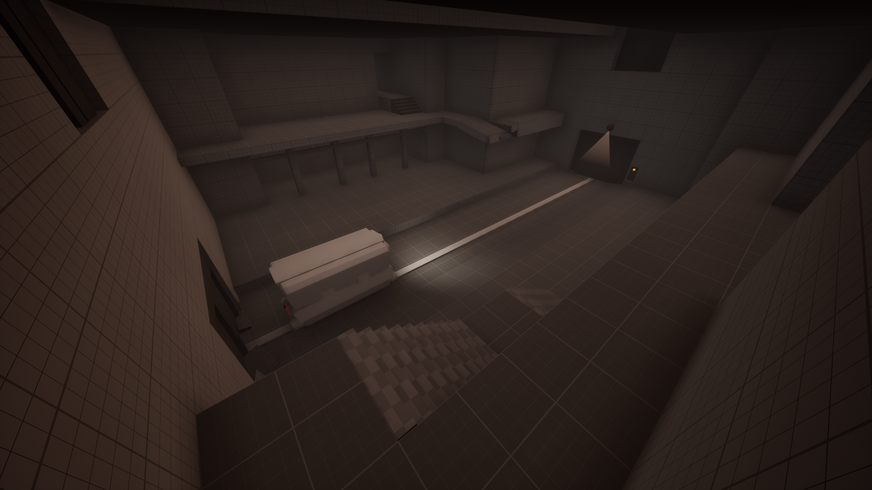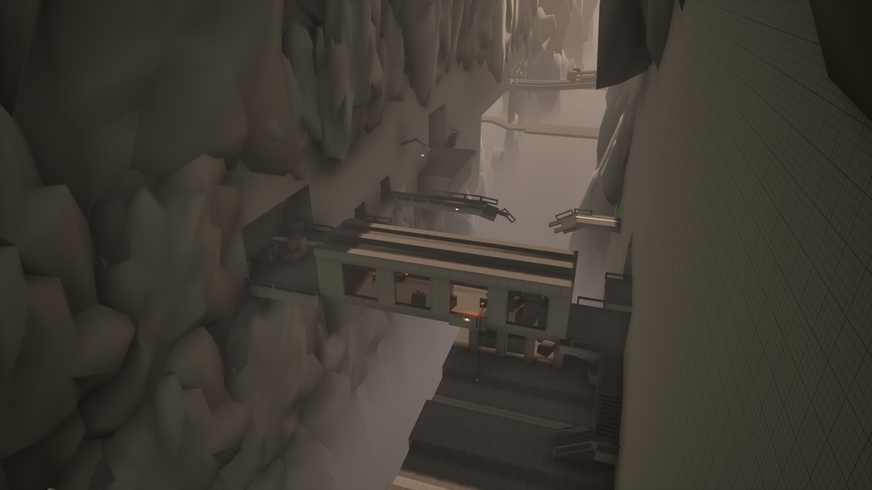

GLOVED UP
LEVEL DESIGN
INTRODUCTION
For this level, I aimed to create a tightly focused linear experience that strikes a careful balance between puzzles and combat while maintaining a strong sense of pacing. Inspired by games like Half-Life-Alyx and Prey, my goal was to design an environment that seamlessly guides players forward while preserving their sense of agency.
The level is set in a vast mining facility where the workers' brain chips have been corrupted, plunging the facility into chaos. As one of the few unaffected workers, the player's goal is to escape the facility using their versatile Grab-Glove.
STORY
-
Solo project
-
6 weeks half time
-
Unreal Engine 5
-
Self-scripted template
-
Models made in blender
BREAKDOWN
EXTERNAL ASSETS
-
LPGenericPropsSet
-
Realistic Starter VFX Pack Vol 2
-
First-person Knife animation Pack
-
safe house ( Used a spline cable blueprint )
OVERVIEW

PART I
PART II
PART III
START
END
1
2
3
4
5
7
6
8
9

Locked door
Ice blockade
Ice socket
Battery socket
Battery
Electric-baton pickup
Button
Grapple-point
Climb point
Railcart
Loading bay

1
Ravine Bridge
2

The railcart

3
Cooling system
4

Railcart intersection
5

Waterpump

6
Moving hooks

7
The Bar

8
The Train-platform
9

TENSION GRAPH

1
2
3
4
5
8
8
6
7
8
9
DESIGN PILLARS
THE GRAB - GLOVE
LEFT HANDED
The Grab-Glove is the main tool at the players disposal and is a central part of how the whole level is designed.
From traversal and puzzle-solving to combat and environmental interaction.I aimed to incorporate the Grab-Glove in as many meaningful ways as possible, ensuring it enhances the level design.
KEY PRINCIPLES
DIEGETIC TUTORIALS
To keep the player immersed in the experience i wanted to introduce new mechanics organically, allowing players to learn through gameplay and discovery rather than direct tutorials. I think this approach really enhanced the feel of player agency that i was after as well as giving the level a more natural flow.


UNORTHODOX PATHS
It was important to me that the level design reinforced the feeling of escaping a broken, dysfunctional facility. To achieve this, I wanted to incorporate as many unintended paths as possible like vents and machinery to really make the player feel like they are finding their way out of the facility.
INTERCONNECTED DESIGN
Although the level is primarily composed of interior spaces, I wanted to ensure players maintained a strong mental map. To achieve this, I designed the layout to sometimes loop back on itself, allowing players to momentarily lose their bearings before naturally reconnecting the spaces and reorienting themselves.




IMMERSIVE PUZZLES
It was important to me that the puzzles felt seamlessly integrated into the world that i had established. To achieve this, I designed them around the facility’s core functions, such as the rail carts and transportation hooks, ensuring they felt like natural extensions of the environment rather than abstract challenges.
DYNAMIC ENCOUNTERS
With only one enemy type throughout the experience, it was important to me that each encounter felt unique and offered multiple solutions. To accomplish this, I designed every encounter like a mini-puzzle where the players that analyze the environment get rewarded with alternate ways to beat the encounter.
PACING
LEVEL STRUCTURE
Pacing was a key focus in this level’s structure and given the intensity of melee combat i really wanted to avoid players feeling overwhelmed or fatigued by the action.
To achieve this, I structured the level into distinct puzzle zones and combat zones, ensuring that they rarely overlapped. I also connected these sections with rest zones that where only straight-forward navigation sections with some pickups to further slow the pacing and let the player rest their brain for a bit. This separation allowed for a smoother gameplay rhythm, giving players time to recover between intense melee encounters.

PUZZLES
I also wanted to ensure that the puzzle sections didn’t disrupt the game’s momentum. For this reason i designed the puzzles to be heavily focused on navigation, encouraging players to move through the environment as they solve them. This approach created a stronger sense of progression, making each puzzle section feel dynamic and rewarding rather than static or isolating.


PICKUPS
I also strategically placed hidden pickups throughout the environment to encourage exploration and prevent players from simply rushing through the level. This not only made the world feel more rewarding to engage with but also naturally improved pacing by prompting players to slow down, analyze their surroundings, and interact more thoughtfully with the space.

CREATING THE COMBAT
INSPIRATION
It was crucial to me that the melee combat felt satisfying and impactful. To achieve this, I drew heavy inspiration from the game Dying Light which has a very satisfying meele-system with great hit-reactions from enemies and often incorporates slow-motion to give hits greater impact.
CREATING IMPACT
I incorporated slight hitstop on the player’s attacks to enhance the feeling of impact. Additionally, when enemies die, the game briefly enters slow motion as they are sent flying by the melee weapon. This mechanic makes every kill feel like a "finisher move," adding a cinematic quality which i think makes combat far more satisfying and rewarding
COMBAT-GLOVE
I wanted to integrate the player’s grab-glove into combat in a meaningful way, so I designed a system where players could throw physics objects at enemies in addition to using it as a grappling-hook to close the distance on enemies. This not only added variety to melee encounters but also infused it with more strategy.

COMBAT BALANCE
To balance the grab-mechanic with the melee system, I introduced a battery system for the grab-glove. When the battery is depleted, the player can no longer throw objects, preventing overuse and encouraging strategic decision-making.
I also designed thrown objects to deal no direct damage but instead put enemies into a vulnerable state. This encouraged players to weave between melee and ranged combat. I think this approach struck a great balance, ensuring that the grab-glove enhanced combat without overpowering the melee system.

PROCESS
GATHERING REFERENCE
I began the project by gathering reference for both visuals and gameplay. This included compiling reference images as well as studying level design from half-life and other games with similiar Gameplay.
I also took huge inspiration from games like dying-light with the impactful meele-combat and the last of us, where each encounter feels like a positional puzzle.





PROTOTYPING
I quickly began prototyping mechanics and puzzles in a player-gym to explore what elements best fit the theme and gameplay I envisioned. This hands-on approach allowed me to find out what was fun early and gave me a clear picture of what direction i would want to take the level.
I had already built a first-person template in an earlier project, which included object-grabbing functionality. I also had some very basic zombie ai from and earlier project. Building on these existing foundations proved to be a great decision, as it allowed me to implement a wider range of engaging mechanics than if I had started from scratch.
BLOCKOUT AND ITERATION
Initially, the facility was intended to be set entirely indoors. However, as I began blocking out layouts and experimenting with the design, I found that the environment felt a bit boring and stale. It felt like the level was missing that "big thing" that would really make it stand out. So i decided to build it around a large ravine.
The ravine became the centerpiece of my blockout, shaping the overall layout as I experimented with different pathways and vistas that leveraged its scale in interesting ways. This also made the interior spaces feel more distinct and engaging by contrast, which I found particularly effective in creating a much more varied and memorable experience.

REFLECTION
If I were to redo this project, I would definitely make the level smaller and more focused. There were so many mechanics and concepts I wanted to incorporate, but in hindsight, a more streamlined experience centered around the railcart or the ice mechanic would probably have been a better approach as i didn’t feel i got the chance to fully explore and utilize those mechanics.
I also would have made the entire experience playable earlier in the process. I spent too much time refining individual areas before the whole level was in a playable state. I believe getting the full experience in a playable form sooner would have greatly benefited playtesting and iteration, allowing for more meaningful adjustments along the way
This has been the most fun and challenging level design project I’ve ever undertaken. Through a lot of trial and error, I’ve gained a much better understanding of pacing and creating effective level flow. The process has been an incredible learning experience and im still very happy with what i managed to create.








